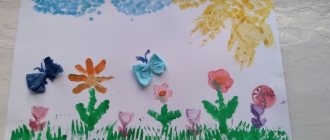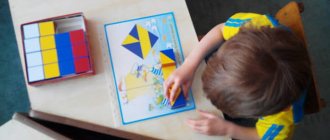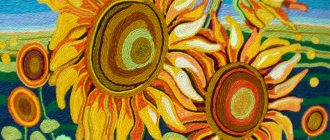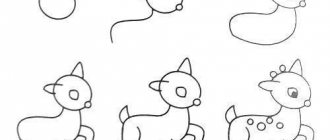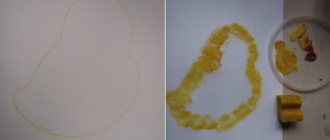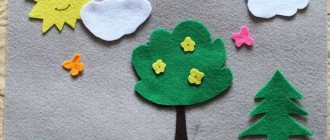Finger painting is not only interesting and fun, but also very useful. With its help, fine motor skills develop, and the baby also makes his first progress in mastering color schemes. The tools are the fingers and palms of little artists, the “object for smearing” is special paints, and the first teacher is mother. How to organize the first lesson correctly, how to develop fine motor skills? You will find answers to these and other questions in this article.
Benefits of classes
Drawing in an unconventional palm technique will allow the child to develop the muscles of his hands, and parents will be able to establish psychological contact with the baby. Such activities not only entertain, but also bring benefits:
- develop motor skills;
- give new knowledge about the shapes of objects;
- teach color recognition;
- develop taste.
Regular finger painting classes allow you to strengthen your hand muscles and develop motor skills, and this has a beneficial effect on speech and abstract thinking. The child will be able to learn about new objects by depicting them, and will also become familiar with geometric shapes, different colors and shades. Such home lessons will help parents prepare their child for the first grade of school.
Small objects help develop coordination of movements. Children will be able to expand their horizons and gain new tactile and visual sensations. The child will receive many pleasant emotions from creative activities, he will develop a taste and a craving for beauty. Children express their experiences through colors. Each drawing reflects the joys and fears of a child. Parents should pay attention to what exactly he depicts.
You can start classes from 10-11 months, but the baby should draw only with the help of his parents. It is better to make the first lessons short - 5-10 minutes. Over time, they can be extended to 20-30 minutes.
You should not force your child to draw; it is better to observe his mood. Creativity requires a good mood and inspiration.
Finger drawing lesson plan in fine arts (art, 1st grade) on the topic
Workshop “Features of organizing the education of first-graders during the adaptation period”
| Antonova Olga Nikolaevna, teacher of Municipal Educational Institution Secondary School 42 | ||
| Subject: fine arts, 1st grade, “Russian School”. Lesson type: gaining new knowledge. Technologies: gaming, information and communication technologies. Form of delivery: lesson-fairy tale. |
Goals:
|
Equipment:
- Visual range: on the board there are images of a magic castle, a fairy-tale meadow in black and white, details for coloring it, a rebus, a Wizard doll, a sheet of paper on which the word “WELL DONE” is written in wax, children have dummies of tassels in red and blue.
- Soundtrack: sound recording of the Wizard’s voice, melody from the intro for the program “Visiting a Fairy Tale,” voices of birds.
Materials and tools:
- gouache of red, yellow, blue colors;
- wet wipes;
- a simple pencil;
- album sheet;
- scissors.
During the classes
I. Organizational moment
Music from the TV show “Visiting a Fairy Tale” is playing.
- Who lives in the castle? Who will come to visit us?
- What do you guys think?
- Let's knock on the castle door and find out. The Wizard's voice sounds.
— Once every 100 years, a Wizard comes to an art lesson and tells fairy tales. Guys, sit back and listen. The wizard tells a fairy tale.
II. Updating of reference knowledge
An image of the Fairytale Glade painting appears.
Children, on the instructions of the Wizard, guess the three primary colors.
| — The first color is the sixth in the rainbow. (Blue.) A blue man-paint appears. -What can blue paint color? (Cloud.) The teacher attaches a blue cloud to the outline of the cloud. - Guess the second color using these words: “chicken”, “sun”, “dandelion”. (Yellow.) A yellow man-paint appears. The sun turns yellow. - The vowels have escaped. Did you guess the third color? (Rebus “KR.SN.Y.”) A red paint man paints flowers. |
- Well done! They returned the Paints. But not the whole picture became colored. Three colors, three colors, three colors. Guys, isn't this enough? Where can we get green? What two colors should you mix? (Yellow and blue.)
— The Blue and Yellow Paints worked hard and painted the grass and the tree. The teacher attaches a green tree crown and grass to the picture.
- Look, guys, how sunny and joyful it has become in the clearing!
III. Communicating the topic and objectives of the lesson
- Wizard, is your fairy tale over? The wizard asks to draw birds.
— To fulfill the Wizard’s request, we will call our assistants. They will help us draw a bird without preliminary drawing.
Physical exercise for hands
Here are my assistants, turn them the way you want: (Look at the open palms.) And this way, and this way, they won’t be offended in any way. (Rub our hands.) One, two, three, four, five. (We clap our hands.) They can’t sit still again. (Shake the brushes.) We knocked (knock on the table), twirled (circular rotations with the brush) and wanted to work. (Rub our hands together.) They will work a little (clap our hands), we will let them rest. (Put your palms together.) We knocked (knock on the table), twirled (circular rotations with the brush), and again went back on the road. (Clap our hands.) IV. Work on the topic of the lesson The teacher does the work together with the children according to the plan: • outline the palm; • see the silhouette of a bird; • schedule. (The teacher shows a new technique for finger painting.)
Physical education session (visual relaxation “Leaves”)
- The wind flew across the clearing, The wind blew away the leaves: Here is an oak one, Here is a maple one, Here is a carved rowan tree, Here is a golden one from a birch tree. And the last leaf - from the aspen tree - was thrown by the wind onto the path.
• Repeat the rules for working with scissors; • cut out the bird.
V. Lesson summary
| Exhibition of works. - Look, Wizard, what beautiful birds the children drew! And the colors became fun. The birds began to sing in the clearing. |
Voices of birds. (Appendix 7.) - Thank you, Wizard, for the magic!
Voice of the Wizard. (Appendix 8.) - Tell the Wizard “Goodbye!”
Close your eyes again, We are flying away from the fairy tale. One, two, three, four, five - We'll go back to class again.
VI. Reflection
— You have two brushes on the table: red and blue. Red color means a joyful, enthusiastic mood, blue color - sad, sorrowful. Choose a brush of the color that matches your mood. “I’m also in a happy mood.” I'll take a brush with red paint and paint a piece of paper. (After applying paint, the word “WELL DONE” appears on the sheet.)
Materials and tools
All materials can be found in any store that sells office supplies. Children do not need professional expensive paints. It is better to choose those with a safe composition, because the child can taste them.
Required tools and materials:
- paper;
- finger or any other paints;
- dry and wet wipes;
- cotton swabs and disks;
- old toothbrushes;
- oilcloth or mat for creativity.
You can choose any paper for drawing - A4 or A3 sheets, Whatman paper, coloring books, colored cardboard. You don’t have to buy expensive goods; just buy a standard album or sketchbook. But the paper in them should be thick so as not to get wet from water. Suitable paints include watercolor, gouache, and special materials for fingers. They can be purchased at any art stores. The colors should be bright; there are watercolors and gouache with glitter. Such materials will interest children. You can draw figures not only with your hands - the child can use cotton pads or sticks, toothbrushes.
It is advisable to seat the baby at a comfortable table, and lay a blanket or pillow on the chair to make him comfortable. It is better to cover the workplace with oilcloth or a special rug. In any case, the children will cover it with paints. It is also recommended to dress the child in old clothes that you don’t mind getting dirty. And to cleanse the skin you need to use dry or wet wipes.
Kids won't be able to draw serious pictures yet.
Their first attempts will resemble meaningless scribbles: dashes, sticks, crooked lines, blots. But the more often the child practices, the more interesting his images will become. With age, technique will improve, and the most talented children will begin to create real masterpieces.
Precautionary measures
Small children get tired quickly; for the first time it is enough to practice for no more than 5 minutes . Further, the child’s attention will not concentrate on creativity. The first few lessons are an adaptation period. You should not set difficult-to-achieve goals while you need to conduct lessons in the form of a game. While drawing, children, with the help of their parents, will be able to study geometric shapes, names of colors, various animals and types of transport, even body parts.
It is important to properly prepare the workplace and monitor the baby. First you need to deal with the paints. If it is watercolor, then it is diluted with water to a paste-like state. Thick gouache should also be made more liquid. Finger paints are ready to use. You can add glitter to them to make drawing more interesting.
It is better to pour the material into a flat saucer or plate. It is difficult for kids to get paint out of a small jar with their fingers; it is much easier to scoop it out of a large bowl. It is recommended to place a bowl of warm, clean water nearby. The child will wash his hands in it in order to continue using a different color. You also need to place a towel nearby, which can be stained with paint.
It is not advisable to leave your baby alone during classes. A small child can be so inventive that he will paint more than just paper . The role of parents during creativity is to channel the children's energy. The mother or father must communicate with the baby, prompt or help him. But you need to be allowed to make mistakes. Let a child draw crookedly or ugly - this is how he still expresses his “I”.
If the baby is not yet a year old, then it is better to provide him with a floor instead of a table. It is advisable to remove the carpet from it and lay down oilcloth. It is also recommended to remove all items that a child could damage. Wardrobes and beds can also be covered with oilcloth, otherwise they may be painted. If parents are afraid that the baby will freeze, you can put a warm blanket under him.
“Finger painting: why and how”
Preparatory stage. (On the knees)
We sit the artist in our arms: in front of us is a white sheet and a jar of paint. It is realistic to start this stage at 4.5-5 months. The student is quite mature - he is interested in everything new, he already gets up in bed and looks around with pleasure. It is at this moment that we begin to introduce colors into his life.
Moreover, several fundamental steps can be identified. We start by drawing ourselves in front of the child. We smear our finger with paint and make a few strokes on his eyes. Do this for a minute at least every day, and let this stage take a month. But at some point, you smear his own finger or palm with paint and move his hand over the paper. But in such a way that the child actively watches it! We ran our hand over the paper, wiped our fingers—the half-minute drawing session was over. And let such classes - with minimal forward movement - take one and a half to two months, and no less. Don't rush anywhere! You must convey to the child a mysterious principle: you can transfer paint from your hand to a white sheet!
Don't put your child in front of a full can of paint right away. Such a stormy beginning can only end in the fact that the first lesson will also be the last. And this will happen both because of the child and because of us. We ourselves will be the first to decide that drawing is too labor-intensive and dirty the apartment. Therefore, the first time you should take a tiny amount of paint; it will be enough for a few minutes of your artistic activity. Or you can come up with something like a sippy inkwell for paint (ask your grandmothers - they remember what that is).
IS GUACHE EDIBLE???
At this stage, we wean the child from eating art material . Or even try to do it! Any paint is an absolutely inedible thing, and you need to remember this! We tried different paints and settled on gouache, as it is the least toxic. Gouache is glue and white.
The first thing an intelligent six-month artist should do is taste the paint. This is a natural, most expected exploratory act of a child. He tests his tongue not because he is small or stupid, but because he clarifies. Or re-specifies. (He will need to try again a few more times to make sure he is not mistaken.) At this moment (for our part) we add a solution of Epsom salts or mustard into the process - after all, this is better than trying gouache. Magnesia sulfate (Epsom salt) costs three rubles at the pharmacy and this is the easiest way to illustrate the word “bitter” and illustrate the word “impossible”! This is natural salt, and not a product of the Russian chemical industry. I tried it, winced, washed it down with some water, the bitterness disappeared. Try not to overdo it, so that this bitterness does not discourage the child from drawing.
Paint Recipes
The technology called “Finger Painting” involves the use of paints. But many parents worry that they may be dangerous for the child. After all, many kids taste them, and they contain many harmful chemicals.
Some mothers prepare their own paints. The ingredients are quite simple:
- 2 tbsp. flour;
- 1.5 tbsp. water;
- 7 tbsp. l. salt;
- 1.5 tbsp. l. vegetable oil;
- glycerol;
- food colorings.
First you need to mix the dry products - flour and salt. Add water to them and stir until thick sour cream forms. Then add vegetable oil. The ingredients can be mixed with a whisk, fork, mixer or blender. Glycerin is added as desired, it gives the paint shine.
The finished mass is poured into different jars; you can use empty containers from gouache or baby puree. Then you need to add dyes. They can be natural - juice of carrots, beets, celery, turmeric. You can also use food colorings that are added to baked goods.
At home, you can prepare three-dimensional paints for finger painting. You will need few ingredients:
- 1 tbsp. flour;
- 1 tbsp. salt;
- 2 tbsp. water.
The products must be thoroughly mixed and placed in different containers. Then dyes are added to them. For additional shine, glitter or glycerin is added to the mixture. Next, the jars are placed in the microwave for 1.5 minutes at 180 degrees. The result will be a voluminous material. While drawing, the paints will lie on the paper so that any image will acquire a 3D effect.
You can also use porridge for cooking:
- 0.5 tbsp. fine-grained cereals;
- water;
- dyes.
Semolina is suitable for creating paints; it is quite small. It is cooked according to the usual recipe; the consistency of the porridge should resemble sour cream. For greater viscosity, you can add PVA glue to the mixture. The mass is also laid out in small jars and mixed with dyes. This material will also allow you to create three-dimensional drawings. But after applying it to paper, you need to handle the painting more carefully - it must dry. You can fix the cereal with regular hairspray.
Tips for parents
Parents should show the little ones exactly how to draw a picture with their fingers. The unusual technique of fine art should interest the child. Use your fingertip to scoop up some paint and make a dot or draw a line on the paper. The baby can repeat this. But you can draw not only with your fingers, but with your entire palm.
Older children enjoy using ready-made templates. You can find them on the Internet and print them or draw them yourself. These are images of fruits, vegetables, animals, transport. They are usually already painted, but have white areas. The child must paint them so that the colors match, or trace the outlines of the drawings .
There are popular pictures that kindergarten teachers use. The finger painting technique is also suitable for depicting natural phenomena. A child can draw the sun, rain, snowfall, and starry night with his hands.
The background is painted over with your fingers, evenly distributing the material over the paper. But you can use colored cardboard. Large images - sun rays, clouds, fish, flowers - are drawn with palms. And small details can be depicted with little fingers, cotton swabs and even toothpicks.
Finger painting will allow you to prepare greeting cards and themed posters for kindergarten. The child will be able to take part in decorating the house for any holiday. And parents will help kids master more complex painting techniques with each new lesson.
Ideas for finger paintings
Finger painting is the most accessible form of creativity for babies starting from six months. At about the age of two or three years, the child will ask the parents to draw something. Then you can use a little trick. Ask your child to make paint impressions with their fingers. And then turn them into different drawings: images of animals, flowers, transport. Older children will also enjoy this method of finger painting. Any preschooler will love the idea of turning their prints into funny drawings. This is an opportunity to develop fine motor skills, imagination, creativity, and an idea to have fun.

